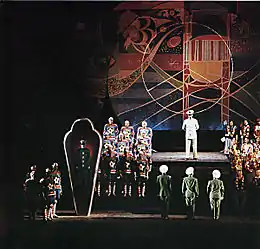Aniara (opera)
Aniara is an opera in two acts by Karl-Birger Blomdahl, with a libretto by Erik Lindegren based on the poem Aniara by Harry Martinson, that was premiered on 31 May 1959.[1] The opera was described by the composer with the ambiguous phrase en revy om människan i tid och rum: "a revue about Man in Time and Space".[2]
| Aniara | |
|---|---|
| opera by Karl-Birger Blomdahl | |
 Premiere production at the Royal Swedish Opera, May 1959. Set by Sven Erixson. | |
| Librettist | Erik Lindegren |
| Language | Swedish |
| Based on | Aniara by Harry Martinson |
| Premiere | 31 May 1959 Royal Swedish Opera, Stockholm |

The score of Aniara is varied and makes full use of a range of musical idioms, including jazz, serial writing and an electronic tape. The narrative is sung primarily by Mimaroben, a bass-baritone, who operates the electronic tape, Mima, the computer, and by the chorus.[1] In essence the opera (and poem) deal with the relationship between the individual and the group through time.
Many representatives of the international press were at the Royal Swedish Opera in Stockholm for the premiere in 1959 at a time when the space age was beginning.[2] Blomdahl said in interview that the opera (in common with his next opera Herr von Hancken) was founded on "modern man's complexity and his basically impossible situation"; Aniara dealt with "the downfall of the group".[3] A production was mounted in Gothenburg in 1994.[4]
Roles
| Role | Voice type | Premiere Cast, 31 May 1959[5] (Conductor: Sixten Ehrling) |
|---|---|---|
| Mimaroben | baritone | Erik Saedén |
| The blind poetess | high soprano | Margareta Hallin |
| Daisi Doody | soprano | Kjerstin Dellert |
| Libidel | dancer | |
| Three chief technicians | 2 tenors, baritone | Sven-Erik Wikström, Arne Ohlson, Bo Lundborg |
| Comedian, Sandon | high buffo tenor | Olle Sivall |
| Isagel | dancer | Loulou Portefaix |
| The Deaf Mute | tenor | Ragnar Ulfung |
| Chefone | bass-baritone | Arne Tyrén |
| Chorus: space cadets, passengers | ||
Synopsis
Controlled by the computer Mima, the space ship Aniara leaves the poisoned Earth, heading for Mars. Through Mimaroben, who is the operator of Mima, the emigrants learn of the evil of mankind.
During the celebration of midsummer, the vessel is thrown off course, causing panic, and forcing a journey to the constellation Lyra which commander Chefone says will last for the rest of the lives of the crew and passengers. When the Earth is destroyed, Mima cannot continue, and Sandon makes jokes about the safety on board, but when the mute describes in signs the end of the world he becomes silent. Chefone blames Mimaroben, who, with the pilot Isagel, is taken away.
The commander deals as best he can with the increased despair and moral deterioration among those aboard, depicted in a scene in a hall of mirrors, where Daisy Dodd, her lesbian partner, and the passengers dance, and the blind poetess speaks of her cult of Light, which has replaced Mima. The body of the dead chief technician is shot into outer space in the direction of the star Rigel. The 20th anniversary of the voyage is celebrated, and the blind poetess ecstatically sees the city of heaven, but is taken away.
The final scene shows the last night onboard where Isagel dances and the blind poetess sings of the joy of death. A light beam sweeps over the dead passengers and Mimaroben prepares for the end. Finally darkness descends over the occupants of the space ship, and the audience in the theatre.
Recordings
The first recording was released in 1960 by Columbia Masterworks (catalog number – M2S 902) featuring Werner Janssen conducting members of Royal Swedish Opera. The first broadcast performance was broadcast by Swedish Radio; a subsequent recording in 1985 with the Swedish Radio Symphony Orchestra was conducted by Stig Westerberg, and included Viveka Anderberg, Björn Haugan, Stefan Parkman, Mikael Samuelson, Thomas Sunnegårdh and Jerker Arvidssonin among the cast (Caprice CAP 22016: 1–2) (CD).
References
- Wiklund A. Aniara. In: The New Grove Dictionary of Opera. Macmillan, London & New York, 1997.
- Thoor A. Opera in Space and in the Round. In: Swedish music – past and present, special edition of Musikrevy. STIM & Swedish Institute for Cultural Relations Abroad, Stockholm, 1966.
- Hambraeus B. Conversation with Karl-Birger Blomdahl. In: Swedish music – past and present, special edition of Musikrevy. STIM & Swedish Institute for Cultural Relations Abroad, Stockholm, 1966.
- "Samtliga uppsättningar s134-168" (PDF). Archived from the original (PDF) on 2012-03-11. Retrieved 2019-07-06.
- Swedish Radio archive: http://smdb.kb.se/catalog/search?q=Aniara+opera+1959